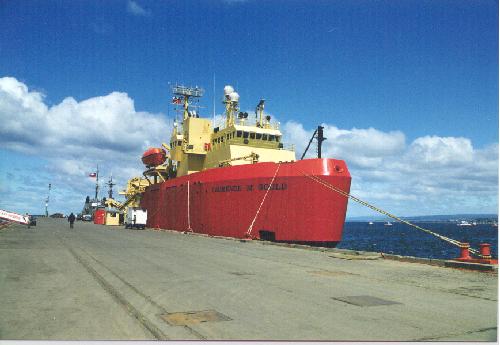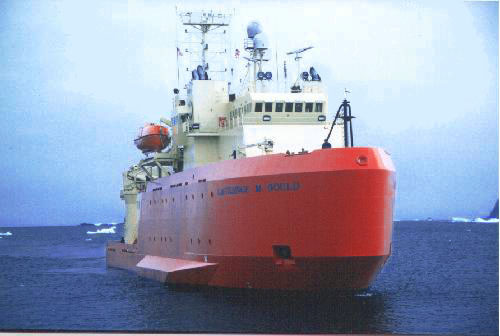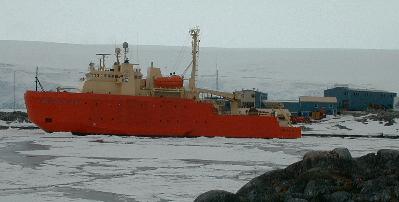Laurence M. Gould


 This image © Wade Jeffrey 1998
This image © Wade Jeffrey 1998
The Laurence M. Gould is the newest of two ice strengthened research ships operating under contract
for the National Science Foundation. The Gould has three
primary responsibilities:
1) To conduct scientific research in Antarctic waters.
The Gould is designed to be a flexible research vessel to investigate many aspects of the marine ecosystem.
2) To supply Palmer station.
With spaces to carry 9 containers and with berthing for personnel, the Gould makes regular stops at Palmer
Station to bring supplies, personnel, and fuel. The Gould also retrogrades the trash from Palmer station.
3) Hazardous Waste Retrograde to the United States.
Every other year, the Gould will take all the hazardous waste generated from Palmer station. With
environmental officials on board, the waste is brought all the way back to the United States for proper disposal.
Antarctic waters are of course usually filled with varying degrees of ice. We all know about the Titanic and
hazards around icebergs, so how does the Gould deal with sea ice and floating glacial ice? Well, the Gould's hull is a
very different design from the Titanic. The steel is a special grade and is very thick. The Titanic also had a
hull whos design was many plates that were riveted together. This type of hull design is no longer used in shipbuilding and the large steel
plates of the Gould's hull are securly welded into place. The Gould (under terms of the contract with NSF) must be able to
make continuous forward motion in 1 foot of first year sea ice, as well as transit pack ice of 3 feet using the backing
and ramming method. The Gould is not rated to enter multi-year sea ice. The longer the sea ice sits,
the stronger it becomes. Glacial ice is made from fresh water as snow is compacted on the land mass of Antarctica
and then flows as glaciers into the oceans forming ice shelves. This ice is
very strong and as chunks break off the ice shelves, they form ice bergs. The key is not to run into the icebergs.
Many of the larger icebergs are visible from quite a distance off. Large tabular icebergs may loom on the horizon,
but these large icebergs eventually break up and melt into smaller pieces. "Bergy Bits" and "Growlers" are two classifications
of smaller chunks of glacial ice. These may be much harder to see visually, but the radar picks up most of the ice and
the crew slightly adjusts course on a constant basis to try to avoid most of it.
Ship's Particulars
Type of Vessel |
Antarctic Research and Supply Vessel (SUBCHAPTER U) |
ABS Star A-1 |
Unrestricted Ocean Service |
ABS Ice Class |
A-1 |
Builder |
North American Shipbuilding Hull #154 |
Year of Construction |
1997 |
Official Number |
1057229 |
Overall Length |
230 Feet (70.2 Meters) |
Length between perpendiculars |
212 Feet (64.7 Meters) |
Breadth (Molded) |
46 Feet (14.0 Meters) |
LWL @ 17'-0" Draft |
202' 6" |
Draft (Min Operational) |
15'0" (4.57 Meters) |
Draft (Normal Operational |
18'3" (5.56 Meters) |
Draft (Load Line) |
19'0" (5.79 Meters) |
Freeboard at Normal Operational Draft |
7.50' (2.286 Meters) |
Lightship Weight |
2754.99 Long Tons |
Deadweight |
1025.68 Long Tons |
Maximum Draft (Loadline) |
19.417 Feet (5.9 Meters) |
Loadline Displacement |
3780.67 Long Tons |
Gross Tonnage |
2966 (International) |
Propulsion |
4575 Horsepower - Caterpiller 3606 (2) |
|
Ulstein controllable pitchpropellers in nozzles |
Performance |
13.5 kts (top speed) |
|
12 kts (service speed) |
Generators |
700 kW Kato - Caterpiller 3412 (3) |
E.P.I.R.B. ID# |
ADCD020F3101001 |
Communications |
VHF: (2) SEA w/DSC |
|
SSB: Sea 330 |
|
JRC INMARSAT B |
|
Saturn Bm C2 INMARSAT |
| Navigation |
Radar: (2) Furuno 2810 |
|
GPS: (2)Raytheon DGPS Nav 398 |
|
Simrad autopilot |
|
Ritchie mag. compass |
|
Datamarine depth sounder |
|
Furuno Doppler speed log |
Capactity |
9 containers |
|
21,700 cubic feet including scientific spaces |
|
58 berths
(Without temporary berthing vans) |
Go to:
 Antarctic index
Antarctic index
Disclaimer
 E-mail Marc at
gentoo100@hotmail.com
E-mail Marc at
gentoo100@hotmail.com
![]() Antarctic index
Antarctic index E-mail Marc at
gentoo100@hotmail.com
E-mail Marc at
gentoo100@hotmail.com 

 This image © Wade Jeffrey 1998
This image © Wade Jeffrey 1998